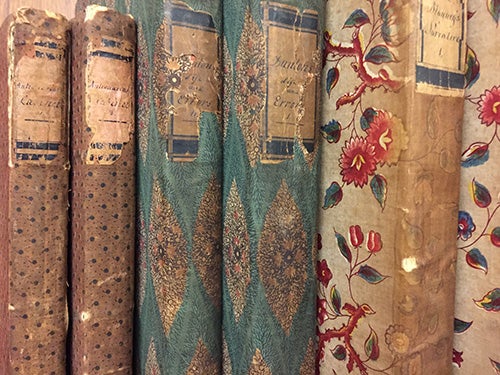From long tables displaying bright covers of contemporary bestsellers to late 19th-century gift books within Special Collections, students, readers, and scholars are surrounded by eye-catching bindings. I long assumed decorative bindings like these were bound up in marketing efforts—a book needs to attract sufficient attention to encourage reading, conversation, and of course purchase of the title. “Cottonian bindings” refined my perspective on these relationships.
“Cottonian” binding refers to a portion of the books (still numbering well over a thousand) in the personal library of Romantic poet Robert Southey. These books were covered in pieces of patterned cloth over their plain paper bindings to protect them from wear, at a much lower cost than the calf or gilt morocco leather bindings in which wealthy book owners often had their paper books rebound. The term “Cottonian” was a sly riff on Sir Robert Bruce Cotton, whose extensive and priceless personal library became the foundation for the British Library. The paper-bound portion of Southey’s library was not even sent out to respected binders or covered by the poet himself. The books were covered by some of Southey’s own daughters, as well as other daughters of British Romantic luminaries—Dora Wordsworth and Sara Coleridge.

The printed fabric bindings varied greatly in design and color, but as you can see were kept consistent across volumes of the same book. The relatively subdued deep red cloth covering Antiquarian and Topographical Cabinet first mimics a literal cabinet—whose purpose is to best feature the objects within it. I find it delightful the Cabinet itself becomes part of a larger cabinet of curiosities, because of the unique story of its binding. The book provides a contrast to the floral motifs encasing the other two-volume works next to it.


The vibrant floral covers of The Life and Errors of John Dunton and Narrative of a Forced Journey through Spain and France as a Prisoner of War visually present celebratory bouquets to the men whose military and literary achievements are praised within the pages. However, in a preface to The Life and Correspondence of Robert Southey, his son Charles shares that the bindings chosen by his sisters were “sometimes contriving a sly piece of satire at the contents of some well-known author by their choice of its covering.” For that reason, there is room for consideration of these floral bindings as more ironic commentary by these women toward men who write self-congratulatory autobiographies.


Cottonian bindings do more than uniquely present some of Robert Southey’s extensive collection, speak to the range of costs of bookbinding, or illustrate the role of young women in off-market book production near the beginning of the 19th century. For instance, The Life and Errors of John Dunton is marked with Robert Southey’s name at the bottom of the title page. Yet these volumes were not identified in Southey’s library by his name or even the label with the work’s title pasted to the spine. They became known by the cloth binding the daughters chose, affirmed by how they are referred to by their binding even now. Women rebound, even began to reclaim, these works by physically preserving and aesthetically making the books known by the bindings they fixed to the books.
The social influence of Cottonian bindings did not remain in the space of Southey’s library. According to Michael Sadleir, the bindings made such an impression on the influential literary figures who passed through the Southey library that publishers were inspired to produce their own cloth bindings with embossed floral work and elaborate designs into their books. With this, a female-driven means of thriftily reinforcing book bindings in the space of a home library made its way into the commercial realm of publishing.
If Sadleir’s argument stands, Cottonian bindings are direct precursors to the highly decorative bindings I was familiar with before. Not only are Cottonian fabric covers highly variable and beautiful, providing commentary on the texts within them, they also facilitate consideration from a range of critical angles. Through these bindings, the Southey influence stretches beyond the messaging and technical influence of Robert’s poems into and beyond the unique, re-covered containers of the wide range of books he owned.
--Anastasia J. Armendariz (C’2019), Paul F. Betz Collection Research Assistant, Booth Family Center for Special Collections
December 12, 2018
